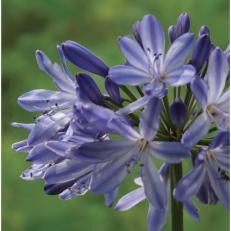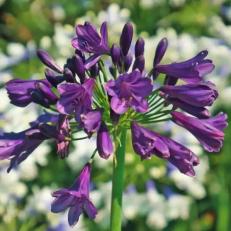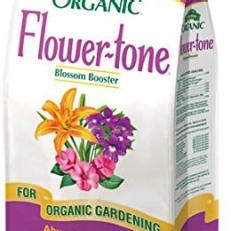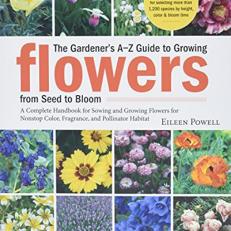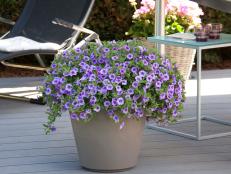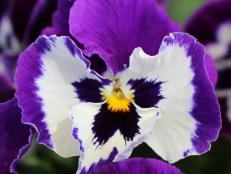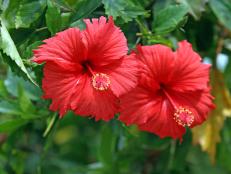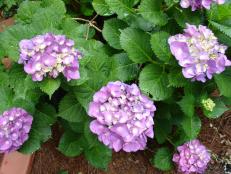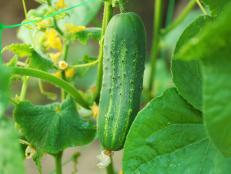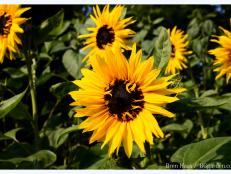How to Grow and Care for Agapanthus
Learn how to successfully plant, tend and enjoy African lily from garden (or pot) to vase.
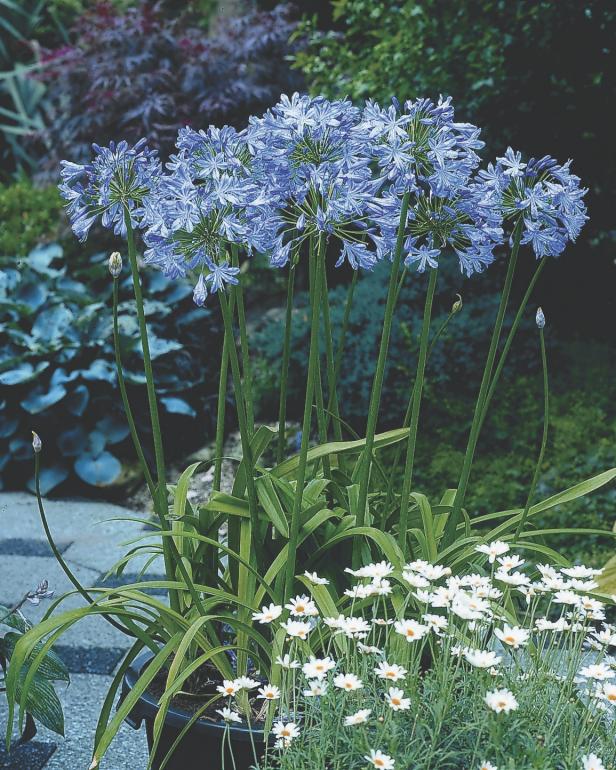
Burpee
Agapanthus 'Blue Heaven,' hardy in Zones 7 to 11, is a disease- and pest free variety that produces majestic sky blue flowers on 3 foot stems surrounded by strap-like leaves. They bloom in midsummer and then again in early fall.

If you don’t yet know agapanthus, you likely recognize it. Agapanthus is a graceful darling of ornamental gardens around the world — and for good reason. When agapanthus bloom in midsummer, they light up the landscape like sparklers, levitating among the fireflies.
Broad blades of emerald foliage arc gracefully over the earth, similar to but more substantial than garlic chives or liriope. Shooting up from the low herbaceous clumps, globe-shaped flower clusters hover atop tall stems. Each plant spreads to about 18 inches wide, with flower height typically from 1-4 feet — although, in places with long growing seasons, certain varieties tower to 6 feet or more.
Also known as lily of the Nile or African lily, agapanthus hails from southern Africa (not actually from the Nile region). While many American gardeners reside on the margins of agapanthus’ hardiness zones (7-10), there are simple ways to successfully grow Agapanthus, even in northern regions. Agapanthus is worth seeking for its charming blue hues, long bloom time, ease of care, toughness in hot climates, excellent cut flowers and penchant for growing in pots. Dive into this guide and discover which type of agapanthus is right for you, along with how to plant, care for and enjoy this summer-blooming botanical treasure.
Agapanthus 101
Agapanthus is a genus of herbaceous, flowering plants that thrive in sunny, well-draining sites. In its native region, Agapanthus ranges from moist grasslands to rocky mountain slopes. The genus contains six distinct species — two evergreen and four deciduous — which vary slightly in their cold hardiness and physical characteristics.
In the late 1600s, botanical explorers brought agapanthus to Europe from southern Africa. Evolving ever since, agapanthus has grown to be widely cultivated and extensively hybridized — highly popular in both formal and cottage gardens across Europe. The vast majority of agapanthus plants offered by nurseries are hybrids, as opposed to the native species that thrive in southern Africa. Through hybridization, horticulturists have selected traits like cold hardiness, increased blooms and plant size (with cultivars from dwarf to 4 feet tall). Blooms can be found in pure white as well as shades of purple and blue. While true blue flowers are hard to find, agapanthus comes close, making it a useful design element in painterly garden palettes.
Types of Agapanthus
Evergreen Agapanthus Species
The species Agapanthus africanus and Agapanthus praecox are evergreen perennials, dependably hardy to Zones 8-10. While these species are similar in appearance, the leaves of A. praecox are longer and broader than A. africanus.
Agapanthus africanus is particularly drought tolerant, hailing from rocky, mountainous slopes. In the wild, this species blooms rarely — only after fire. It is unlikely you find true A. africanus under cultivation as it has been widely hybridized for more frequent, non-fire-dependent blooms. Notable cultivars include Elaine, New Blue and Albus.
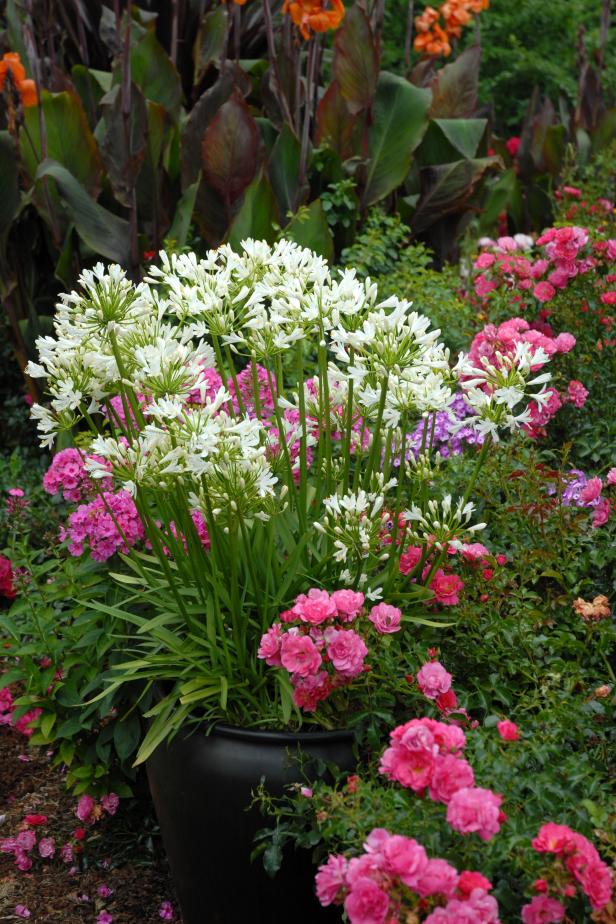
Tesselaar Plants
Dwarf varieties of agapanthus can reach 2 feet tall, while others mature at 4-5 feet. Pictured: Snow Storm Agapanthus
Agapanthus praecox is sometimes called A. orientalis or A. umbellatus. In the wild, it ranges from grasslands to rocky slopes. This is the most common species found under cultivation, prized for its prism of tall blooms, from white to lavender to blue. Sought-after cultivars include Blue Moon, Flora Pleno and Stevie’s Wonder.
While less hardy than the deciduous species, evergreens may be brought indoors over winter and kept in bright light until spring. Check the care tag nursery plants to confirm hardiness — some evergreen or semi-evergreen cultivars may have a greater tolerance for cold than others. When overwintering, water infrequently to avoid root rot. For the sake of easy seasonal transitions, it may be best to grow evergreens in porch pots if you live north of Zone 8 rather than digging them up every autumn.
Deciduous Agapanthus Species
There are four species of deciduous agapanthus: A. inapertus, A. coddii, A. caulescens, and A. campanulatus. These agapanthus lose their leaves in late autumn, overwintering with greater hardiness than their evergreen counterparts — dependably in Zones 7-10, with reports of success in Zone 6 under mulch. Most semi-evergreen and deciduous agapanthus for sale are hybrid cultivars, marrying desirable qualities of different species.
Far Reaches Farm offers a beautiful cultivar called Sky (A. inapertus subspp. hollandii ‘Sky’). The species A. inapertus features uniquely tubular flowers. Sky is aptly named as its blooms are pale blue in color.
The species A. coddii and A. caulescens are not reliably offered by nurseries.
While also uncommonly available, A. campanulatus is notable for its more open flower faces (as opposed to the tighter, trumpet-like blooms of other species). Explore varieties like ‘Wendy’ and ‘Albidus’ to get acquainted with this charming agapanthus.
In colder climates (north of Zone 7), deciduous types may either be heavily mulched over winter or the fleshy roots dug and stored for replanting in spring.
Hybrid Agapanthus Species
Most agapanthus we find while shopping are hybrid cultivars, bred specifically for traits like taller stems, specific colors, variegated foliage, more prolific blooms or increased winter hardiness. Shop around for varieties that suit your needs.
Do you need a low, colorful border for the front edge of a flower bed? Try a dwarf variety like Peter Pan or Tinkerbell. Are you looking for a tall, striking statement? Check out the towering blue variety 'Stevie’s Wonder,' which reaches at least 3 feet tall in Zone 7 (according to Plant Delights Nursery); in Zones with elongated seasons, stems may reach 6 feet to 8 feet tall (as reported by Emerisa Gardens).
The Headbourne Hybrids are particularly worth seeking, known for cold hardiness, drought resistance, deciduous habit and adaptability to less fertile soils.
If unusual colors and patterns entice you, seek varieties like Back in Black for its deep purple stems and blossoms, Silver Moon for its variegated foliage, or Twister for its shadowed bicolor effect.
How to Plant Lily of the Nile
Shopping for Agapanthus
Many local and online nurseries offer a range of agapanthus cultivars. While agapanthus is often sold as a bulb, what you will actually receive is a bare-root plant. Ask your neighborhood nursery or botanical garden about cultivars that do well in your climate. If you’re unsure where to start shopping or what varieties to look for, start with online research at Terra Ceia Farms, Emerisa Gardens, Plant Delights Nursery, Burpee, and Monrovia. While they cannot ship to the US, Littlewood Agapanthus Farm in Australia has a stunning website to explore.
Buy Agapanthus
Planting Agapanthus in the Garden
Before planting agapanthus in the ground, first, choose a site that receives full sun or partial shade. In areas with scorching summers, afternoon shade is helpful. Ideal soils will be rich, loose and loamy. However, in the book “Successful Southern Gardening”, Sandra F. Ladendorf notes that agapanthus will tolerate clay soils as long as they are amended for improved drainage.
The more ideal the location, the more prolific and long-lasting you can expect your agapanthus to be. Especially if you plan to overwinter plants in the ground, ensure the soil is well-draining to avoid root rot. While loosening and enriching the soil with compost or leaf mold (and if necessary, sand), incorporate a balanced, organic fertilizer like Espoma Flower Tone.
After the last frost in spring, plant your agapanthus roots 1 inch deep and 12 inches apart. While agapanthus spreads to around 18 inches, its flowering is more profuse when roots can overlap. Water well at planting time.
Planting Agapanthus in Pots
Counterintuitively, agapanthus enjoy being rootbound — either closely spaced in the ground or with their roots contained in pots. For this reason, container planting agapanthus may yield more prolific blooms than in-ground planting, according to Eileen Powell’s helpful text, “The Gardener’s A-Z Guide to Growing Flowers from Seed to Bloom.”
To achieve the desired constraint, plant one agapanthus per 12 inch pot. If the pot is any larger, add more plants — when agapanthus roots have too much space, they will produce copious foliage and few flowers (and the same thing will happen if they are overfertilized).
Bury the bare roots under 1 inch of potting medium that is richly fertile and well-draining. If drainage seems poor, or you are working with compost or garden soil, add sand or vermiculite. Mix a balanced, organic fertilizer into the soil at planting time and water well. Pots should be kept in full sun to part shade, and moved indoors over winter. Indoors, potted agapanthus enjoys bright, indirect light.
Buy Supplies
How to Care for Agapanthus
Watering and Fertilizing Agapanthus
Agapanthus thrives with consistent watering but requires exceptionally well-drained soil to avoid rot. Along with steady water, using an organic, balanced fertilizer keeps plants blooming consistently through summer into early fall. Always follow fertilizer instructions precisely. For abundant flowering, try Fox Farm’s liquid “Big Bloom” plant food or Espoma’s granular “Flower Tone."
Mulching Agapanthus
Layering 2-3 inches of leaf mold, bark or straw mulch around plants is a helpful way to retain soil moisture, suppress weeds and support healthy microbial activity in the soil. In addition to these universal benefits, northerly gardeners may find greater success overwintering deciduous agapanthus when a generous layer of mulch is applied in autumn, as mulch insulates roots from temperature swings.
Agapanthus Pests and Disease
Agapanthus are impressively pest-resistant, even unappealing to most rabbits and deer. However, there are a few disease issues to look out for, as noted by Burpee: anthracnose, botrytis, powdery mildew and root rot.
To avoid these fungal and rot issues, keep the area free of diseased plant matter, avoid overhead watering, ensure good drainage and maintain ample airflow — especially in humid areas. If you notice fungal disease, remove affected plant parts swiftly so it can’t spread. Contact your local cooperative extension or Master Gardener volunteers for guidance on integrated pest and disease management, or help determining which kind of disease you're plants have.
Deadheading Agapanthus
Remove spent blooms by cutting the stem back to foliage level. This practice will help plants continue to send their energy into new flowers, potentially blooming from summer to early fall. In autumn as the season comes to a close, let flowers dry on their stems. The wand-like dried blooms are lovely left as-is in the garden or cut and used in everlasting floral designs.
Dividing Agapanthus
After four or five years you will likely start to notice fewer blooms coming from your agapanthus. Or, if the plants are potted, the tightly wound roots may even crack the pot. At this point, it’s time to divide and replant the agapanthus. Simply dig up the plant and then use a knife or hori hori knife to saw and pry the tangled root ball in half.
Once you have two or more smaller sections, soak the roots in water for an hour or so to help acclimate and hydrate the severed roots. Then, replant them at 12-inch spacing and water them well. Evergreen forms may be divided in either spring or fall, but deciduous ones should only be divided in fall (according to Powell).
Agapanthus Toxicity
All parts of agapanthus are toxic, in particular the roots, leaves and sticky sap, which can cause skin irritation upon contact. If ingested, Agapanthus causes pain, nausea and mouth ulcers. Immediately seek medical attention for suspected ingestion by people or pets.
Designing Gardens With Agapanthus
The cool-toned colors, spherical shapes and varying heights of agapanthus make them adaptable plants for a range of garden aesthetics. Their stately forms stand gracefully alongside tidy, formal boxwood borders, making them common choices for more traditional landscapes. Thinking outside the box, agapanthus make lively cottage garden specimens with playful, soft blooms like foxglove, hollyhock, and climbing roses. In a wilder direction, agapanthus’ striking lines and pops of color create interesting contrast when woven through soft grasses, as seen in Tom Massey Studio’s Perennial Sanctuary Garden. The grasses create a lilting backdrop for the glittering blue agapanthus, which dances in dynamic harmony with orange helenium and red dahlias.
How to Cut Agapanthus Flowers
Agapanthus is a striking, long-lasting cut flower popular with florists. When the tiny blooms that make up each globe start to pop open, it’s time to harvest.
Since its sap is toxic, harvest with care by placing cut stems directly into a bucket of water to rest, and change the water before arranging. Let agapanthus’ graceful spirit speak for itself and use a slender, tall vase. Snipping stems to stand at slightly varied heights will give each bloom a bit of breathing room, lending depth to your arrangement.
While agapanthus combines beautifully with tall branches and blooms, displaying them alone is all you need for an elegant arrangement. In addition to enjoying fresh agapanthus flowers, the dried flower heads make excellent creative fodder as well, whether gathered in a ceramic vessel or as a textural wreath ingredient. There are layers of beauty and enjoyment for those who tend agapanthus with care.

.-Battle-on-the-Beach-courtesy-of-HGTV.-.jpg.rend.hgtvcom.196.196.suffix/1714761529029.jpeg)





